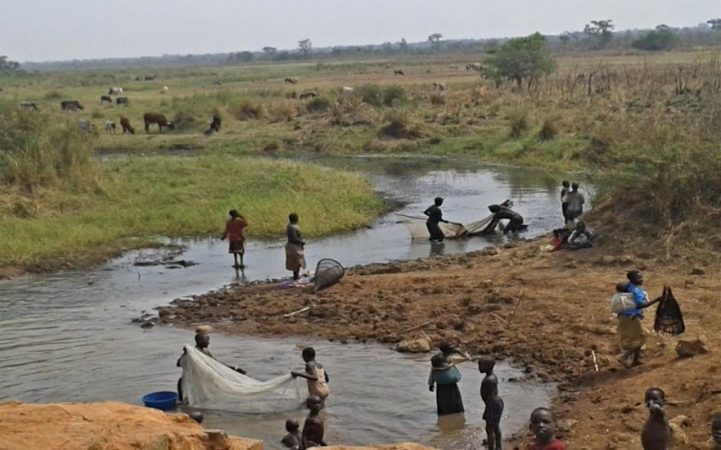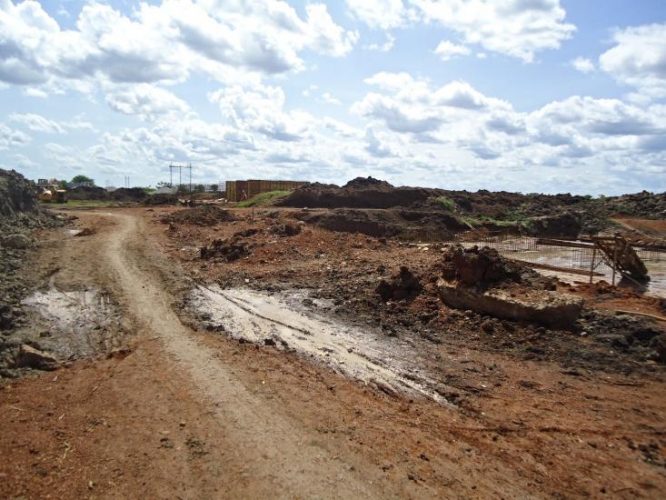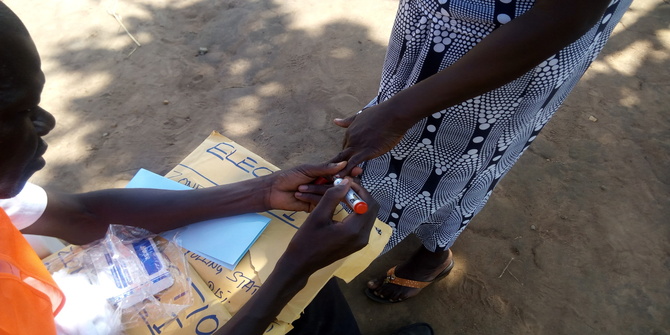Along the River Agago in northern Uganda, the lasting effects of violent conflict have exacerbated environmental degradation. With the ecosystem essential to the livelihoods of large local populations, what actions are being taken to counter the environmental decline?
Drawing from the research project Deconstructing Notions of Resilience, this is the second in a two-part blog series exploring the unique complexities that post-war settings add to issues of diminishing natural environments.
The River Agogo is seeing a trajectory of degradation in Uganda’s Agogo district, caused by local populations’ acts of resilience to support their livelihoods in the aftermath of the region’s conflict since 2008. That is, since the return to peace following the withdrawal of the Lord’s Resistance Army, the ecosystem on which people are reliant has been in decline, leading to the use of new, harmful fishing practices caused by changes to the river flow. These changes are significant, with about 127,000 and 178,000 people impacted by the river in the Agago District and Pader District respectively.
Action to tackle environmental degradation
Since 2008, there are neither existing records nor practices to indicate that any form of substantive intervention aimed at altering degradation of River Agago has been undertaken. Government and international humanitarian interventions in any aspect of post-conflict rehabilitation have been lacking on this side of the Acholi region, including for the environment.
In parts of the region where there have been interventions, they has been based on a universal policy that does not recognise local cultural context. Experiences from other areas in the region suggest that even in places where conservation interventions have been implemented, for instance the IUCN’s intervention in the Aswa River catchment areas, efforts are falling short of altering current environmental trajectories. This is partly to do with the fact that most interventions are driven merely by national policies and priorities at the expense of actual needs and challenges unique to individual communities. Yet environment and community cultures are intricately linked.
Research in the years after the war documented a critically distorted demographic structure in northern Uganda. A generation of older people with the vital knowledge, experience and life-skills for survival were almost wiped out during the conflict, creating huge gaps in the transfer of relevant human intellectual advances (culture, knowledge, norms, ideas and customs) to the younger generation to preserve their survival. The region emerged from conflict in 2008 with a young population without the knowledge, tools and resources to replicate the pre-war society destroyed by the two-decade long war. A large proportion of this generation had neither the opportunity to witness the river in its pre-IDP healthy state nor healthy alternatives.
If indeed the ecosystem decline of River Agago is to some extent an epitome of a ‘culture crisis’, then we should be asking whether existing interventions take into account and confront this social aspect. Nevertheless, the sustained failure to alter current degradation trajectories requires innovations emerging from far beyond mere government policies, laws and governance systems. Notwithstanding dozens of national legislations and policies relating to environmental conservation and rehabilitation in existence since 2008, River Agago is yet to see an intervention. Yet any intervention attempting to address issues regarding natural resource management and governance, protection and biodiversity conservation will inevitably have to negotiate these ‘culture crises’. It must therefore seek to radically move away from current practices or risk falling into the same traps.
The key to unravelling issues regarding community awareness, attitudes, behavioural change and participation towards conservation exists somewhat in social learning and social memory. Evidence suggests these prove to be a better source of innovation than government laws, policies and governance structures. It is for this very reason that interventions focused on ‘engaging’, ‘educating’, ‘empowering’ and ‘encouraging’ deliver better outcomes. When conditions for social learning are present, particularly when there are stores of social memory to draw on, innovations have better chances of tipping the ecosystems toward transformation.

The challenge with the social learning and social memory perspective, as River Agago reveals, is that it assumes the local community to be the primary actor in ecological degeneration. This assumption risks unintentionally placing blame and responsibilities on affected communities for actions or inactions they are otherwise not responsible for. In River Agago’s case, the biggest and leading actor accelerating environmental degradation has been the government. This is shown in environmentally destructive civilian protection, destructive development projects and inaction towards degradation in the same period.
The destructive development projects are usually in the form of the bridge construction, which are implemented in the most environmentally destructive manner possible. Thousands of tons of exhumed soil (see photo 2.1) are left to be washed away by the river during the rainy season. While environmentally unsustainable, there are no measures taken both during and after the construction to facilitate the recovery of the river to its pre-project state. Instead the projects further escalated silting and degradation of the river beyond imagination (see photo 2.2).

When we look at events with our own eyes, it is easy for us to grasp the scale of destruction arising from these communities’ actions, and assign them responsibilities. But when we look beyond the superficial layers it becomes clear that the consequence of communities’ actions on the river’s ecosystem only constitute a fraction of factors responsible for its degradation. International humanitarian and government actions and inactions during and after the war present far greater implications for the environment. Unless interventions take this perspective and understand context specific to the community, there is a risk of unintentionally blaming communities for actions they are not responsible for.
There is need for more research to establish scientifically the extent of degradation and how best social learning and social memory can be harnessed into interventions aimed at comprehending post-war environmental degradation. One thing is clear: altering degradation trajectories in many parts of post-war northern Uganda requires challenging the attitudes and perceptions of those whose survival, in one way or another, enmeshes with River Agago’s ecology.
Photo: Bricklaying, by Esteban Castle on Unsplash.






love to see detailed information on the extent to which the LRA war has impacted negatively on environment in the entire northern district of Uganda